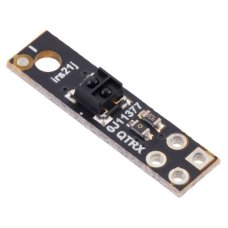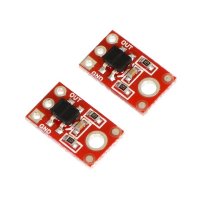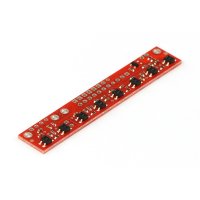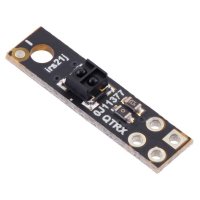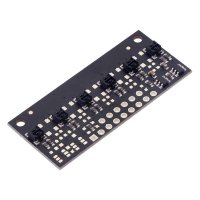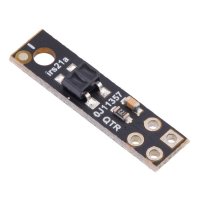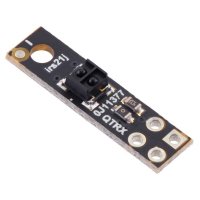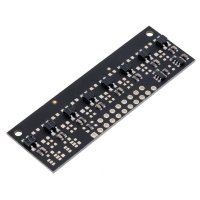This IR LED/phototransistor pair is great for precisely identifying changes in reflectance (like line detection). It operates from 2.9 V to 5.5 V and offers dimmable brightness control independent of the supply voltage. In general, the closer the object, the higher the contrast between light and dark readings, but high-reflectance objects are generally detectable out to around 80 mm. This version features a high-performance QTRXL sensor with lenses and a high-brightness emitter for extra-long range.
| Sensors | Size | Output | Max current | Optimal | |
| (mm) | LED | board | range | ||
| 1 | 5.0 × 20.0 | analog | 30 mA | 32 mA | 20 mm |
Specifications:
- Dimensions: 5.0 × 20.0 × 4.4 mm (see the dimension diagram for more details)
- Operating voltage: 2.9 V to 5.5 V
- Sensor type: QTRXL
- Sensor count: 1
- Full-brightness LED current: 30 mA (independent of supply voltage)
- Max board current: 32 mA
- Output format: analog voltage (0 V to VCC)
- Optimal sensing distance: 20 mm
- Maximum recommended sensing distance: 80 mm
- Weight: 0.25 g
QTR family overview:
These reflectance sensors feature a linear array of infrared emitter/phototransistor pair modules in a high-density (4 mm pitch) or medium-density (8 mm pitch) arrangement, which makes them well suited for applications that require detection of changes in reflectivity. This change in reflectivity can be due to a color change at a fixed distance, such as when sensing a black line on a white background, as well as due to a change in the distance to or presence of an object in front of the sensor. A variety of sensor counts and densities is available so you can pick the ideal arrangement for your application. Since the outputs are all independent, you can connect just some of the channels to attain an irregular or non-standard sensor spacing.

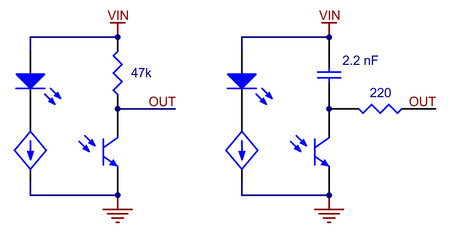
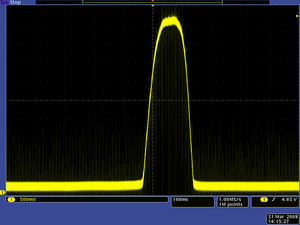
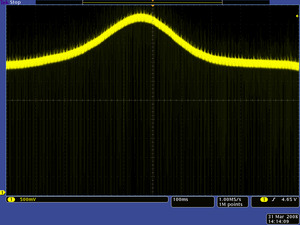
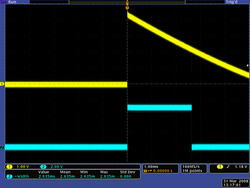
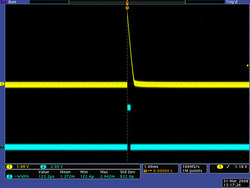
- Units with five or more sensors in a high-density (HD) arrangement have two emitter control pins: CTRL ODD and CTRL EVEN. By default, these are connected together with a 1 kΩ resistor and pulled up, turning on all the emitters by default and allowing them to be controlled with a signal on either pin, but the CTRL ODD and CTRL EVEN pins can be driven separately for independent control of the odd-numbered and even-numbered emitters.
- Units with three or more sensors in a medium-density (MD) arrangement also have two emitter control pins since these are made by only populating every other sensor on an HD board, but only the CTRL ODD pin will have an effect on these versions (it is not possible to independently control alternate emitters).
- Units with four or fewer sensors have a single CTRL pin that controls all of the emitters.
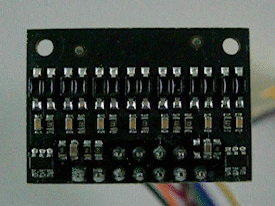
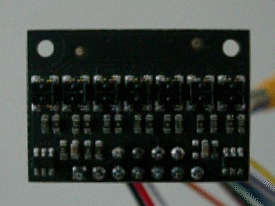
| Dimming | Emitter | Dimming | Emitter | |
| level | current | level | current | |
| (pulses) | (%) | (pulses) | (%) | |
| 0 | 100.00% | 16 | 46.67% | |
| 1 | 96.67% | 17 | 43.33% | |
| 2 | 93.33% | 18 | 40.00% | |
| 3 | 90.00% | 19 | 36.67% | |
| 4 | 86.67% | 20 | 33.33% | |
| 5 | 83.33% | 21 | 30.00% | |
Pololu 4501/4601/4541/4641 QTRXL-HD-01A-01RC Reflectance Sensor 1-Channel
- Brand: Pololu
- Product Code:Pololu-QTRXL-HD-01A-01RC1-Channel
- Reward Points:2
- Availability:In Stock
- रo 229.00
-
रo 220.00
- Price in reward points:229
-
- 25 or more रo 221.00
- 60 or more रo 219.00
- 100 or more रo 210.00
- 300 or more रo 208.00
Available Options
Related Products
Pololu 2459 QTR-1RC Reflectance Sensor (2-Pack)
The Pololu QTR-1RC reflectance sensor carries a single infrared (IR) LED and phototransistor pair. T..
रo 399.00 रo 416.00
Pololu 961 QTR-8RC Reflectance Sensor Array
This sensor module has 8 IR LED/phototransistor pairs mounted on a 0.375" pitch, making it a great d..
रo 802.00 रo 835.00
Pololu 4443/4343 QTRX-MD-03A Reflectance Sensor Array 3 - Channel 8mm Pitch
Description This array of IR LED/phototransistor pairs is great for precisely identifying change..
रo 470.00
Pololu 4446/4346 QTRX-MD-06A-06RC Reflectance Sensor Array 6 - Channel 8mm Pitch Low Current
Description This array of IR LED/phototransistor pairs is great for precisely identifying change..
रo 898.00
Pololu 4101/4201 QTR-HD-01RC-01A Reflectance Sensor 1-Channel 5mm Wide
Description This IR LED/phototransistor pair is great for precisely identifying changes in refle..
रo 191.00
Pololu 4501/4601/4541/4641 QTRXL-HD-01A-01RC Reflectance Sensor 1-Channel
This IR LED/phototransistor pair is great for precisely identifying changes in reflectance (like lin..
रo 220.00 रo 229.00
Pololu 4148 QTR-MD-08RC Reflectance Sensor Array 8-Channel, 8mm Pitch, RC Output
This array of IR LED/phototransistor pairs is great for precisely identifying changes in reflectance..
रo 602.00 रo 628.00
Tags: Pololu, Reflectance, Sensor, Analog-Output, Long-Range

